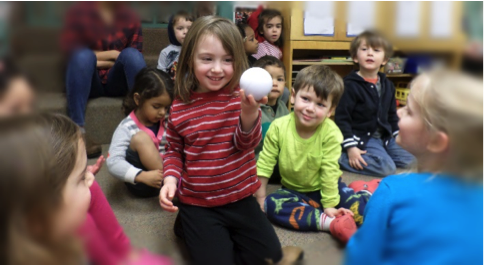Autonomously detecting interaction with an affective robot to explore connection to developmental ability: Laura Boccanfuso
 This research employs a simple, expressive robot to elicit affective response in young children and explore correlations between autonomously-detected play with the robot, affective response and developmental ability. In this study, we introduce a new, affective interface that combines sound, color, movement and context to simulate the expression of emotions. Our approach exploits social contingencies to emphasize the importance of situational cues in the interpretation of affective state. We examine responsivity to the robot’s simulation of emotions and the validity of a novel technique for measuring physical interaction in the context of unstructured play with a robot.
This research employs a simple, expressive robot to elicit affective response in young children and explore correlations between autonomously-detected play with the robot, affective response and developmental ability. In this study, we introduce a new, affective interface that combines sound, color, movement and context to simulate the expression of emotions. Our approach exploits social contingencies to emphasize the importance of situational cues in the interpretation of affective state. We examine responsivity to the robot’s simulation of emotions and the validity of a novel technique for measuring physical interaction in the context of unstructured play with a robot.
Free play is an important part of development and is considered by many to be the leading source of development during a child’s preschool years. Employing robust robots in the context of natural play is especially attractive because it increases opportunities for conducting studies in diverse settings and across broad populations. Further, leveraging technology to capture information indicative of child development is advantageous because child responses can be elicited and data can be collected in an objective, repeatable way. We invited a goup of young children at various ages and stages of cognitive development, to: (1) evaluate the efficacy of using captured motion data to autonomously detect physical patterns of play while interacting with a robot, (2) examine relationships between physical patterns of play and observed affective response and, (3) explore associations between developmental ability and play or affective response. This pilot study demonstrates that aggregate patterns of physical interaction with a robot are distinguishable through autonomous data collection. Further, statistical analyses demonstrates that developmental ability may be directly related to how a child interacts with and responds to an emotion-simulating robot.
One of the unique aspects of this work is that it examines how early play can be autonomously detected by a robot and can be used to flag developmental differences between children at a very early age. This research contributes to a broader understanding of affective response in young children and the connection between play and developmental ability using a novel interaction design with a non-humanoid robot. Analyses of captured accelerometer, gyroscopic signal data and corresponding videos confirms that characteristic patterns of play during unstructured interaction with a robot are identifiable through autonomous data collection. Results from our investigation also indicate some significant relationships exist between play activities, affective response and developmental ability. Future investigations will continue to examine the insights gained through this study to address many new, compelling research questions. An ongoing study with a group of children diagnosed with autism spectrum disorder (ASD) will further inform the validity of this approach for identifying early emerging developmental differences in children and possibly contribute to a new method for augmenting early detection techniques.